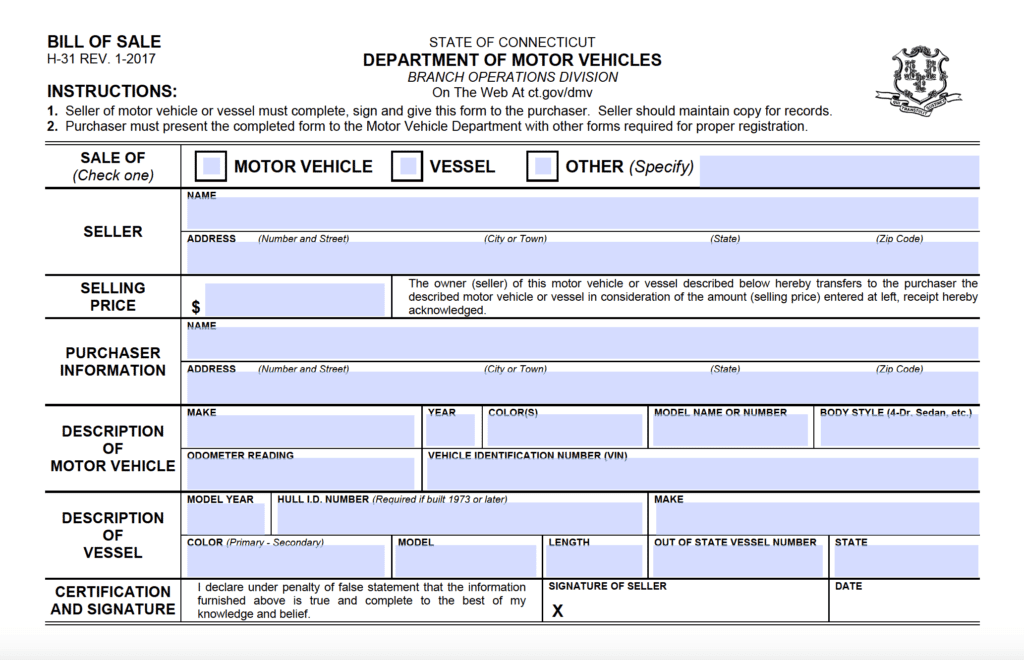The Connecticut DMV bill of sale form is a vital document when it comes to selling a vehicle to a private party, as well as buying. It simply notes specific information about the vehicle, buyer/seller, and of course the sale itself. Connecticut legally requires a bill of sale to be presented when registering a vehicle that has been purchased from a private party. Besides the fact that it’s required by law, the bill of sale form yields other benefits such as providing proof for tax purposes, as well as releasing liability from the owner.
How to Register a Vehicle
Visit your nearest DMV location to register your new or used vehicle. Be sure to come equipped with the materials listed below:
- The title under the new owner’s name.
- The Bill of Sale acquired at the time of sale.
- An approved emissions test – in congruence with Sec. 14-164c. (You may bring your vehicle to one of Connecticut’s emissions testing centers for evaluation. Some vehicles do not require an emissions test, find out whether or not your vehicle is excluded by visiting the nearest VIN station for verification.)
- A completed copy of Form H-13B (the Connecticut Registration and Title Application).
- A valid insurance ID card that contains the name of the person registering the vehicle.
- A standard form of identification (driver’s license, state ID, passport, learner’s permit, etc.)
Payment for the process (fees range depending on the type of vehicle being registered).
How to Register a Vessel
The State of Connecticut obligates any vessel with a motor, sailboat or personal watercraft (jet ski) to be registered in order to be operated on a body of water within or on the coastline of the state. If you wish to use an out-of-state registered vessel on state waterways you may do so for a maximum of 60 days.
You can then visit any Connecticut DMV office with the following paperwork for submission:
- A completed Connecticut Application for Vessel Registration and Certificate of Number Decal (Form B-148).
- The filled and signed official Bill of Sale for the State of Connecticut.
- Proof of ownership of either A manufacturer’s Certificate of Origin or current title and registration if the vehicle was purchased used.
- A form of valid identification such as a Connecticut state ID or driver’s license.
- Verification that you have paid the sales and use tax in the State of Connecticut.
- Payment for all applicable fees and taxes.
How to Write
Step 1 – Download in Adobe PDF.
Step 2 – Sale of – Select what is being sold:
- Motor Vehicle
- Vessel
- Other (if none of the boxes matches, click Other and specify the type)
Step 3 – Seller Information – Enter the following information of the person selling the vehicle:
- Name
- Address (include the “Number and Street”, “City or Town”, “State”, and “Zip Code”)
Step 4 – Selling Price – Enter the number (in dollars) of the amount the vehicle is being sold for.
Step 5 – Purchaser Information – Insert the following buyer information:
- Name
- Address (include the “Number and Street”, “City or Town”, “State”, and “Zip Code”)
Step 6 – Description of Motor Vehicle – This form requires that you list the following vehicle descriptions:
- Make
- Year
- Color(s)
- Model Name or Number
- Body Style (4-Dr. Sedan, etc.)
- Odometer Reading
- Vehicle Identification Number (VIN)
Step 7 – Description of Vessel – If you are dealing with a vessel, provide the following description details:
- Model Year
- Hull I.D. Number (Required if built 1973 or later)
- Make
- Color (Primary – Secondary)
- Model
- Length
- Out of State Vessel Number
- State
Step 8 – Certification and Signature – Seller must read the preliminary statement and provide the:
- Signature of Seller
- & Date



0 comments
Comments are closed.